Doing effective shoulder workouts is key to building an aesthetic upper body.
That’s because the shoulders are central to the symmetry and balance of your entire upper half.
What’s the “secret” to building full, proportional shoulders?
Training each head of your deltoid muscles equally.
In other words, you have to allocate a third of your shoulder training to your anterior deltoids (“front delts”), another third to your lateral deltoids (“side delts”), and the remainder to your posterior deltoids (“rear delts”).
Follow these guidelines and commit to the process, and you will build the broad, masculine shoulders you want.
- Best Exercises for a Full Shoulder Workout
- 1. Standing Overhead Press
- 2. Push Press
- 3. Seated Overhead Press
- 4. Seated Dumbbell Shoulder Press
- 5. Standing Dumbbell Shoulder Press
- 6. Arnold Press
- 7. Machine Shoulder Press
- 8. Dumbbell Side Lateral Raise
- 9. Cable Side Lateral Raise
- 10. Upright Row
- 11. Dumbbell Rear Lateral Raise
- 12. Machine Reverse Fly
- 13. Barbell Rear Delt Row
- The Best Shoulder Workout for Mass
- Training Tips for Building Shoulder Mass
- Train your shoulders with 10-to-20 weekly sets.
- End every set 1-to-2 reps shy of muscle failure.
- Once you hit the top of your rep range for one set, increase the weight.
- Take the right supplements.
- FAQ #1: How many shoulder exercises should I do per workout?
- FAQ #2: Is it OK to train shoulder every day?
- FAQ #3: What exercises make your shoulders bigger?
Table of Contents
Best Exercises for a Full Shoulder Workout
Building strong, broad shoulders isn’t complicated.
It mostly comes down to getting stronger at overhead pressing and using targeted shoulder exercises for the side and rear delts to round out your shoulder development.
Here are the best exercises for your full shoulder workouts:
1. Standing Overhead Press
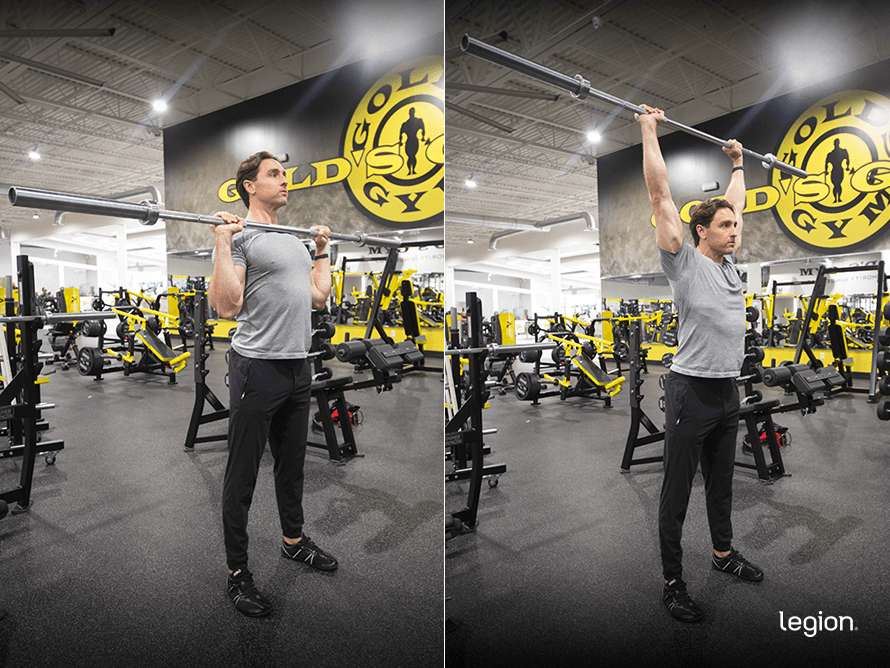
Why: The overhead press is a full shoulder workout in a single exercise—it trains your front, rear, and side delts, rotator cuff muscles, and upper back. It also allows you to handle heavy weights safely and progress regularly, so it’s an outstanding exercise for overall shoulder mass and strength.
How to:
- Set a barbell in a rack at the same height as your upper chest.
- Grip the bar with a shoulder-width grip and your palms facing away from you.
- Unrack the barbell, step backward, and plant your feet just outside of shoulder width.
- Push the bar toward the ceiling until your arms are straight.
- Reverse the movement and return to the starting position.
2. Push Press
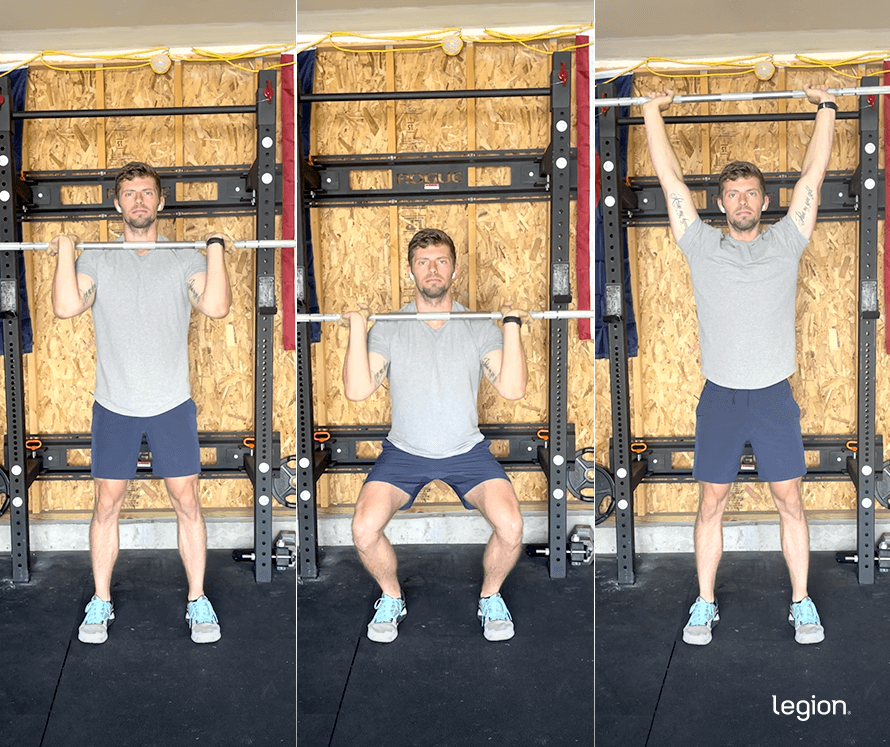
Why: The push press is a dynamic shoulder exercise that allows you to use lower-body momentum to press heavier weights overhead. As such, it’s not only fundamental for building shoulder mass but also essential for developing explosive power, which is particularly beneficial for athletes looking to enhance shoulder strength and size.
How to:
- Set a barbell in a rack at the same height as your upper chest.
- Grip the bar with a shoulder-width grip and your palms facing away from you.
- Unrack the barbell, step backward, and plant your feet just outside of shoulder width.
- Drop your butt 3-to-6 inches by bending your knees, then shoot your hips upward and explosively straighten your knees.
- Press the bar straight up using the momentum generated by your lower body.
- Reverse the movement and return to the starting position.
3. Seated Overhead Press
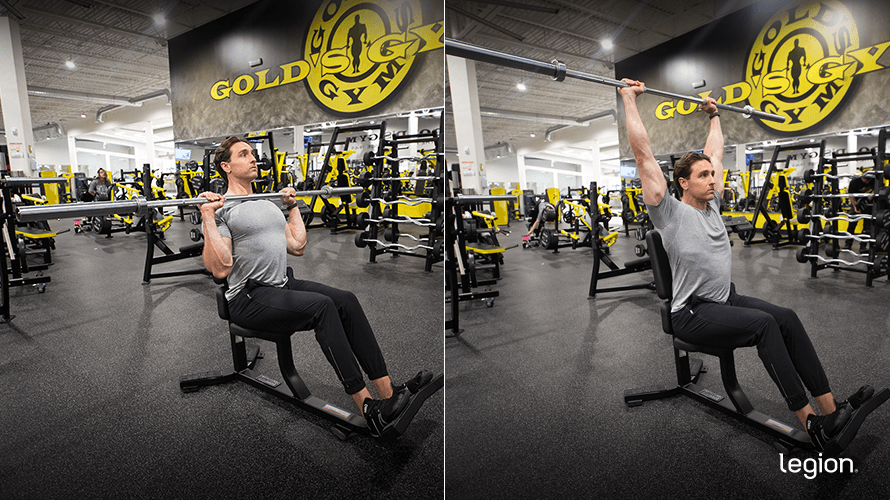
Why: The seated overhead press is a staple in many full shoulder workouts because it doesn’t involve as much core stability as standing overhead presses. This means you can lift heavier weights and progress faster on the seated overhead press than most other shoulder exercises, making it ideal for gaining shoulder mass.
How to:
- Set up an upright bench in a squat rack or use a seated barbell overhead press station.
- Set a barbell in the rack at about shoulder height when standing.
- Sit down and grip the bar with a shoulder-width grip and your palms facing away from you.
- Unrack the barbell and lower it to your collarbone.
- Press the bar toward the ceiling and return to the starting position.
4. Seated Dumbbell Shoulder Press
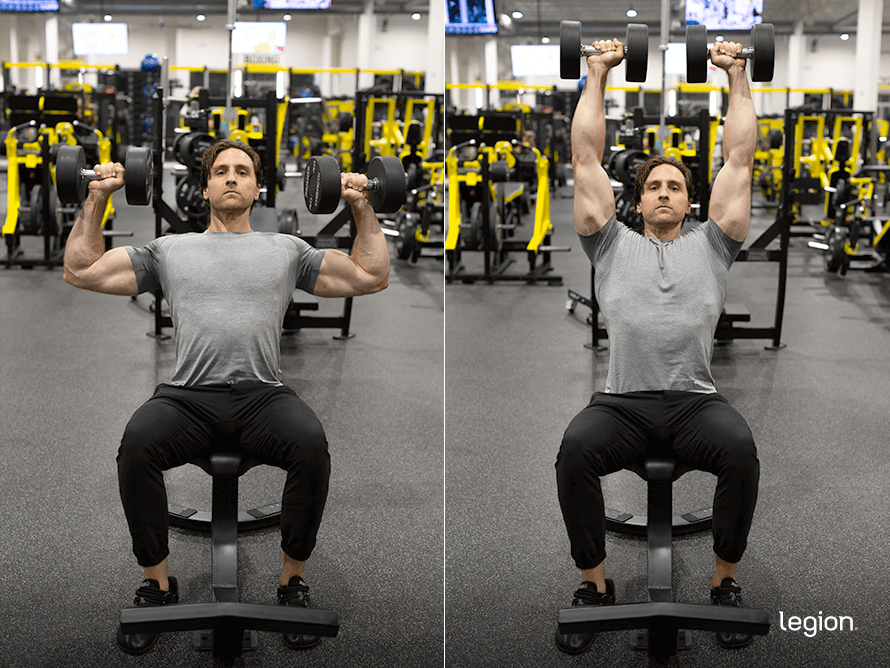
Why: The dumbbell shoulder press trains all three heads of the delts as well as your traps, making it a top-tier exercise for developing the entire shoulder region.
How to:
- Sit on an upright bench and hold a dumbbell in each hand, resting them on your thighs.
- Hoist the dumbbells up so you’re holding them just above your shoulders with your palms facing away from you.
- Press the dumbbells toward the ceiling until your arms are straight.
- Lower the dumbbells and return to the starting position.
5. Standing Dumbbell Shoulder Press
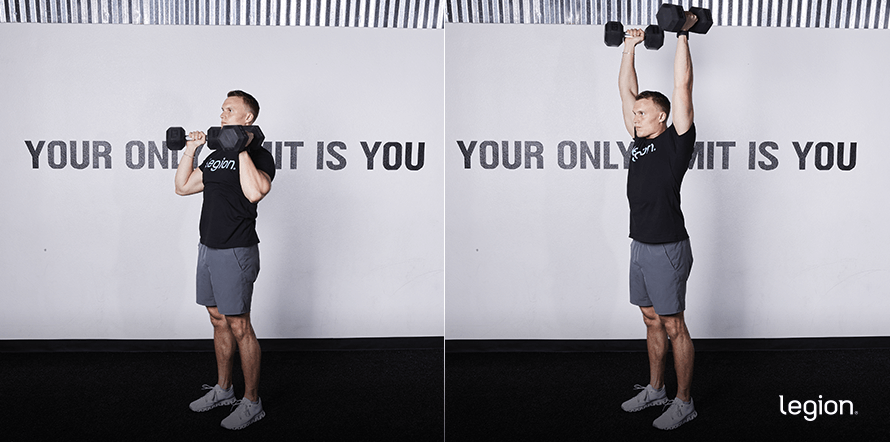
Why: Research shows the standing dumbbell shoulder press trains all three heads of the deltoids to a higher degree than most other overhead pressing exercises, so it’s an excellent variation for a full deltoid workout.
- Stand upright with your feet shoulder-width apart and a dumbbell in each hand.
- Hoist the dumbbells up so you’re holding them just above your shoulders with your palms facing away from you.
- Press the dumbbells toward the ceiling until your arms are straight.
- Lower the dumbbells and return to the starting position.
6. Arnold Press

Why: The Arnold press contributes to well-rounded shoulder mass by emphasizing your side delts more than other overhead pressing variations. In other words, it’s particularly well-suited to people looking to add width and size to their delts.
How to:
- Sit on an upright bench and hold a dumbbell in each hand, resting them on your thighs.
- Hoist the dumbbells up so you’re holding them just in front of your shoulders with your palms facing you.
- Press the dumbbells straight overhead while rotating your wrists until your arms are straight and your palms are facing away from you.
- Reverse the movement and return to the starting position.
7. Machine Shoulder Press
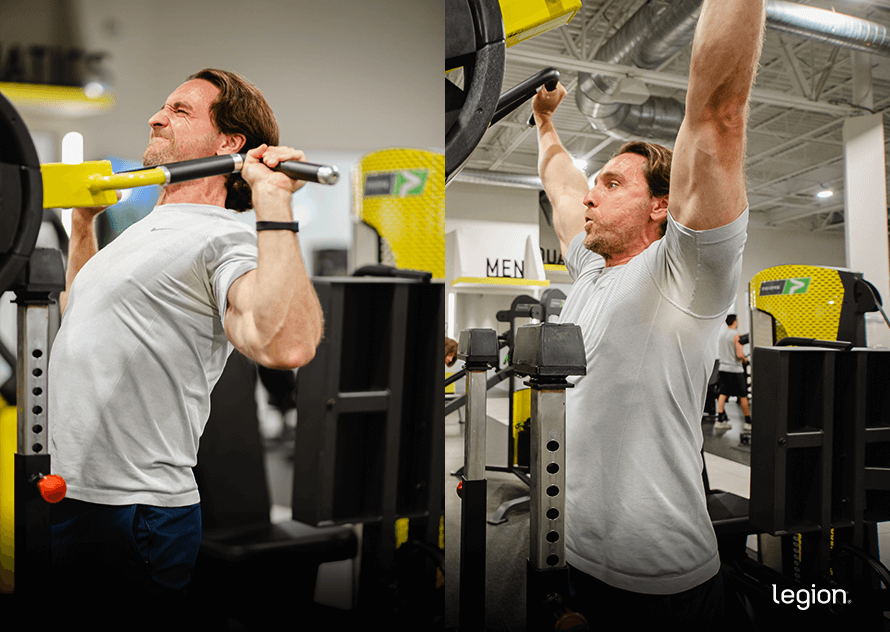
Why: The machine shoulder press is a good option for training your deltoid muscles if you’re new to weightlifting, working around an injury, don’t have access to a barbell or dumbbells, or want to change up your training.
How to:
- Adjust the shoulder press machine’s seat so the handles are about the same height as your ears, then sit down.
- Grip the handles with your palms facing away from you, then press them toward the ceiling until your arms are straight.
- Reverse the movement and return to the starting position.
8. Dumbbell Side Lateral Raise
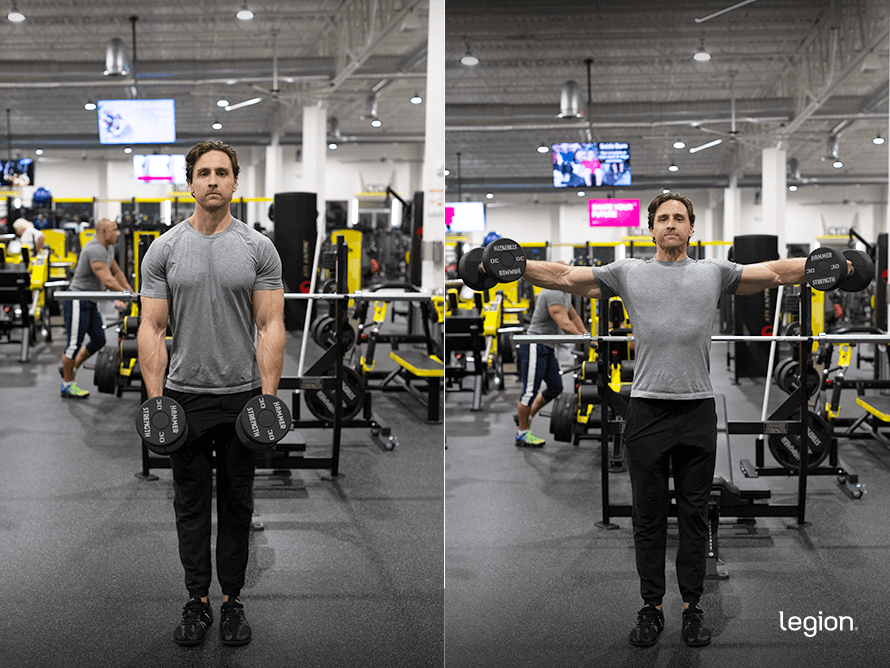
Why: The dumbbell side lateral raise isolates your side delts, making it perfect for building broad, complete shoulders.
How to:
- Stand up straight with a dumbbell in each hand.
- Raise the dumbbells out to your sides until your upper arm is parallel to the floor.
- Reverse the movement and return to the starting position.
9. Cable Side Lateral Raise

Why: Like the dumbbell side lateral raise, the cable lateral raise isolates the side delts, which is crucial for building wide, proportional shoulders.
How to:
- Set the pulley on a cable machine to the lowest setting and attach a single handle attachment.
- Stand with your feet either touching or shoulder-width apart, parallel to the handle, and your right foot closer to the handle than your left.
- Grab the handle with your left hand and the machine with your right hand (most people prefer to grab the metal column that holds the pulleys), then lean your body to the left until your right arm fully extends.
- Raise your left hand out to the side until your upper arm is parallel to the floor.
- Reverse the movement and return to the starting position.
- Once you’ve completed the desired number of reps, switch sides and repeat the process with your right arm.
10. Upright Row
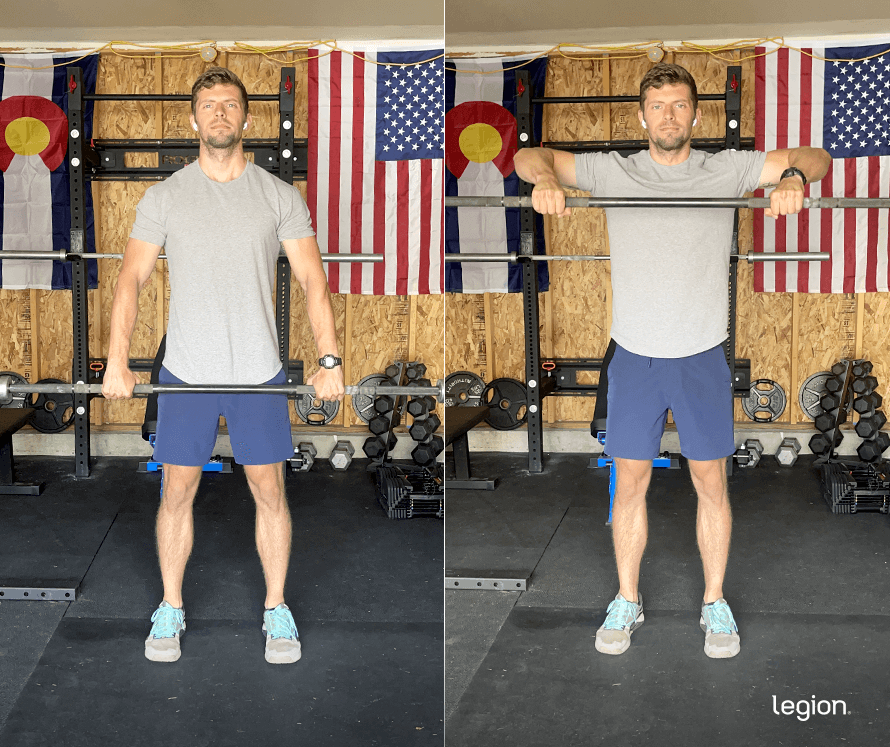
Why: The upright row trains your side delts similarly to the side lateral raise, making it an excellent exercise for rounding out shoulder development. That said, some people find the upright row unkind on their rotator cuff muscles and shoulder joints. To avoid this, simply raise the weight until your upper arm is parallel to the floor and no further.
How to:
- Stand up straight and hold a barbell in front of your thighs with your palms facing you.
- Lift the bar straight upward until your upper arms are parallel with the floor, keeping your elbows higher than your forearms throughout the movement.
- Reverse the movement and return to the starting position.
11. Dumbbell Rear Lateral Raise
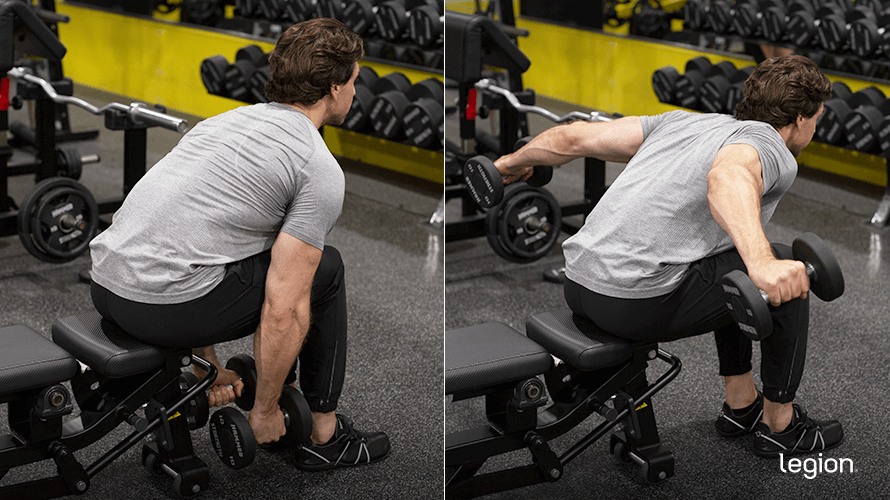
Why: Many weightlifters neglect their rear delts compared to their front and side delts, which can cause strength and size imbalances that blight your upper-body aesthetics and increase your risk of injury. The dumbbell rear lateral raise helps you avoid this by prioritizing your rear delts.
How to:
- Whether standing or seated, bend at the hips so that your upper body is as close to parallel to the floor as possible.
- Hold a dumbbell in each hand, and while keeping your back flat, lift the dumbbells out to the side until your upper arm is parallel to the floor. As you lift the dumbbells, squeeze your shoulder blades together.
- Reverse the movement and return to the starting position.
12. Machine Reverse Fly
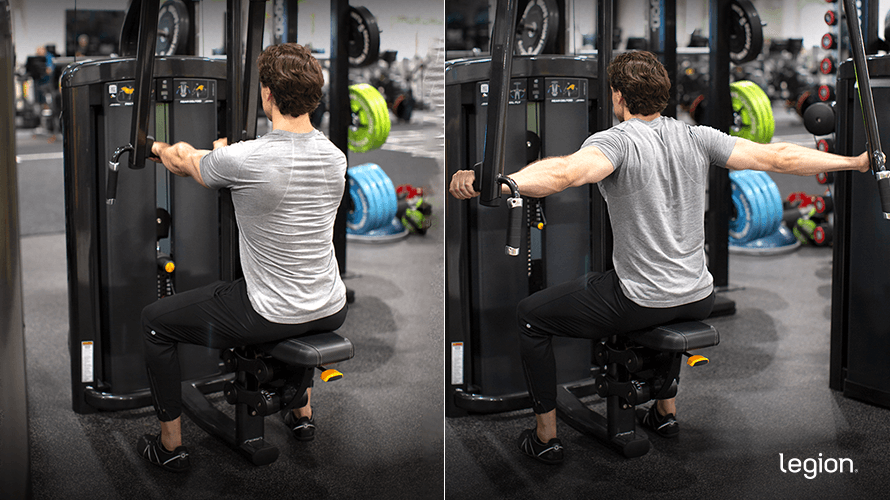
Why: The machine reverse fly isolates the rear delts, the often-neglected muscles on the rear of your shoulder that are crucial for complete shoulder development and mass.
How to:
- Sit down with your body facing the machine and grab the handles with your palms facing down.
- While maintaining a slight bend in your elbows, move the weight back in an arc until your arms are directly out to your sides (or slightly behind your body). As you lift the weight, squeeze your shoulder blades together.
- Reverse the movement and return to the starting position.
13. Barbell Rear Delt Row
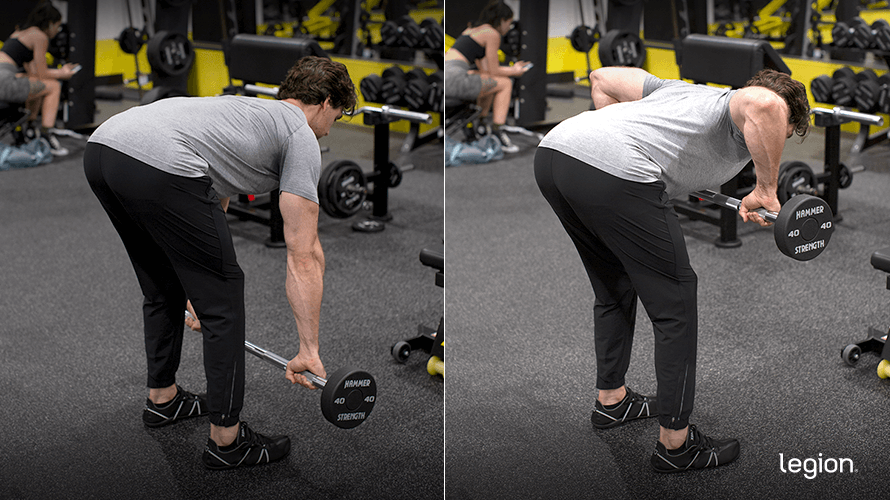
Why: The barbell rear delt row trains your posterior deltoids similarly to the dumbbell rear lateral raise, ensuring full shoulder development and contributing significantly to overall shoulder mass and strength.
How to:
- Position your feet about shoulder-width apart with your toes pointed slightly outward.
- Grab a barbell with a slightly wider than shoulder-width grip and your palms facing you.
- Flatten your back so it’s roughly parallel to the floor, and let your arms hang straight down.
- Pull the barbell to your mid-chest, flaring your elbows at about a 60-degree angle relative to your body. As you lift the weight, squeeze your shoulder blades together.
- Reverse the movement and return to the starting position.
The Best Shoulder Workout for Mass
Below is a simple and effective shoulder workout that helps you build proportional mass and strength in all three heads of the deltoids:
- Overhead Press: 3 sets of 4-to-6 reps with 2-to-4 min rest
- Arnold Press: 3 sets of 4-to-6 reps with 2-to-4 min rest
- Cable Side Lateral Raise: 3 sets of 6-to-8 reps with 2-to-3 min rest
- Dumbbell Rear Lateral Raise: 3 sets of 6-to-8 reps with 2-to-4 min rest
Training Tips for Building Shoulder Mass
Train your shoulders with 10-to-20 weekly sets.
To optimize their development, train your deltoids with 10-to-20 weekly sets.
Guys who’ve followed a strength training program for under 2 years should target 10-to-15 weekly sets of shoulder exercises, and those with over 2 years of training experience should strive for 15-to-20 weekly sets.
Completing 10-to-15 sets of shoulder exercises in one session should be challenging but doable.
I you’re aiming for more than 15 weekly sets, trying to do them in one workout is impractical. Instead, spread your sets across 2-to-3 weekly workouts.
End every set 1-to-2 reps shy of muscle failure.
To maximize shoulder mass and strength gains, take most of your exercises to within a rep or two of muscle failure—the point at which you can’t complete a rep despite giving maximum effort.
Ask yourself at the end of each set, “If I absolutely had to, how many more reps could I have gotten with good form?” If the answer is more than two, increase the weight or reps to make your next set more challenging.
Once you hit the top of your rep range for one set, increase the weight.
For example, let’s say your shoulder workout calls for 4-to-6 reps of the overhead press. If you get 6 reps for a set, add 10 pounds (total) for your next set and work with that weight until you can (eventually) press it for 6 reps, and so forth.
If you get 3 or fewer reps with your new (higher) weight on your next sets, reduce the weight by 5 pounds to ensure you can stay within your target rep range (4-to-6) for all sets.
Follow this pattern of trying to add reps or weight to every exercise in every workout.
Take the right supplements.
The best supplements for maximizing shoulder mass are:
- Protein powder: Taking protein powder is a convenient way to give your body the nutrients needed to build muscle tissue and recover from workouts. If you want a clean and delicious protein powder, try Whey+ or Casein+.
- Creatine: Creatine boosts muscle and strength gain, improves anaerobic endurance, and reduces muscle damage and soreness from your workouts. If you want a natural source of creatine that also includes two other ingredients to enhance muscle growth and improve recovery, try Recharge.
- Pre-workout: A quality pre-workout helps you train harder by enhancing energy, mood, and focus, increasing strength and endurance, and reducing fatigue. If you want a natural pre-workout containing clinically effective doses of 6 science-backed ingredients, try Pulse with caffeine or without.
(If you’d like even more specific advice about which supplements you should take to reach your health and fitness goals, take the Legion Supplement Finder Quiz, and in less than a minute, you’ll know exactly what supplements are right for you. Click here to check it out.)
FAQ #1: How many shoulder exercises should I do per workout?
You typically only need to do 3-to-4 exercises in a full shoulder workout. You can arrange this in many ways, but the structure I tend to use is as follows:
- Exercise #1: This is your main strength-building exercise in the workout, so it should be one that allows you to handle heavy weights and make consistent progress. A barbell overhead pressing exercise, such as the standing or seated overhead press, is usually the best option.
- Exercise #2: A dumbbell overhead pressing exercise, such as the standing or seated shoulder press or Arnold press. Using dumbbells for this exercise allows you to find and fix any strength or size imbalances you might have. If you’re very time-pressed, you could skip this exercise since you’ve already done an overhead press earlier in the workout.
- Exercise #3: An exercise that isolates the side delts, such as the dumbbell or cable side lateral raise. This exercise is key to adding shoulder width.
- Exercise #4: An exercise that isolates the rear delts, such as the dumbbell rear lateral raise, machine reverse fly, or barbell rear delt row. These exercises fill out the often-overlooked rear delts for balanced, full shoulders.
FAQ #2: Is it OK to train shoulder every day?
Yes, you can train your shoulders in every workout. Keep in mind, however, that most upper body exercises involve the delts to some degree, so you probably already train your delts indirectly in most sessions.
Thus, you don’t need to change much about a well-designed training program to train your delts in every workout. For example, if you follow my 5-day Bigger Leaner Stronger workout, here’s how your routine looks:
- Mon: Push
- Tues: Pull
- Wed: Upper Body A
- Thurs: Legs
- Fri: Upper Body B
- Sat: Rest
- Sun: Rest
The routine’s structure means you already train your delts four days per week: you emphasize your front delts on Mondays, your rear delts on Tuesdays, and basically train your entire shoulders on Wednesdays and Fridays.
To alter the program so that you train your shoulder every day, you only need to add 3 sets of a shoulder exercise to Thursdays. A good option would be some extra volume for your side delts—3 sets of 6-to-8 reps of the dumbbell or cable side lateral raise or the upright row would do the trick.
FAQ #3: What exercises make your shoulders bigger?
The most effective exercises for building shoulder mass are those that allow you to train all three heads of the deltoids, lift heavy weights safely, and handle progressively heavier weights over time. Top choices include the seated and standing overhead press and shoulder press, Arnold press, push press, and machine shoulder press.
To develop truly stand-out shoulders, also do exercises that target the side and rear delts specifically, since these “heads” typically get less stimulation than the front delts during presses. Good options for adding size to these muscles are the dumbbell and cable side lateral raise, upright row, dumbbell rear lateral raise, machine reverse fly, and barbell rear delt row.
+ Scientific References
- Saeterbakken, Atle H., and Marius S. Fimland. “Effects of Body Position and Loading Modality on Muscle Activity and Strength in Shoulder Presses.” Journal of Strength and Conditioning Research, vol. 27, no. 7, July 2013, pp. 1824–1831, https://doi.org/10.1519/jsc.0b013e318276b873.
- Raizada, Shiny , and Amritashish Bagchi. Comparison among the EMG Activity of the Anterior Deltoid and Medial Deltoid during Two Variations of Dumbbell Shoulder Press Exercise. Oct. 2017, www.researchgate.net/publication/322132613_Comparison_among_the_EMG_Activity_of_the_Anterior_Deltoid_and_Medial_Deltoid_During_Two_Variations_of_Dumbbell_Shoulder_Press_Exercise, http://dx.doi.org/10.5958/0976-5506.2017.00411.9.
- Schoenfeld, Brad J , et al. The Upright Row: Implications for Preventing Subacromial Impingement. Oct. 2011, www.researchgate.net/publication/232210633_The_Upright_Row_Implications_for_Preventing_Subacromial_Impingement, http://dx.doi.org/10.1519/SSC.0b013e31822ec3e3.
- Page, Phil. “Shoulder Muscle Imbalance and Subacromial Impingement Syndrome in Overhead Athletes.” International Journal of Sports Physical Therapy, vol. 6, no. 1, 2011, pp. 51–8, www.ncbi.nlm.nih.gov/pmc/articles/PMC3105366/.
- Franke, Rodrigo , et al. Analysis of Anterior, Middle and Posterior Deltoid Activation during Single and Multijoint Exercises. June 2014, www.researchgate.net/publication/263292517_Analysis_of_anterior_middle_and_posterior_deltoid_activation_during_single_and_multijoint_exercises.
- Stokes, Tanner, et al. “Recent Perspectives Regarding the Role of Dietary Protein for the Promotion of Muscle Hypertrophy with Resistance Exercise Training.” Nutrients, vol. 10, no. 2, 7 Feb. 2018, p. 180, www.mdpi.com/2072-6643/10/2/180/pdf, https://doi.org/10.3390/nu10020180.
- Jd, Branch. “Effect of Creatine Supplementation on Body Composition and Performance: A Meta-Analysis.” International Journal of Sport Nutrition and Exercise Metabolism, 1 June 2003, pubmed.ncbi.nlm.nih.gov/12945830/.
- Eckerson, Joan M., et al. “Effect of Creatine Phosphate Supplementation on Anaerobic Working Capacity and Body Weight after Two and Six Days of Loading in Men and Women.” The Journal of Strength and Conditioning Research, vol. 19, no. 4, 2005, p. 756, https://doi.org/10.1519/r-16924.1.
- Bassit, Reinaldo Abunasser, et al. “Effect of Short-Term Creatine Supplementation on Markers of Skeletal Muscle Damage after Strenuous Contractile Activity.” European Journal of Applied Physiology, vol. 108, no. 5, 3 Dec. 2009, pp. 945–955, https://doi.org/10.1007/s00421-009-1305-1.









